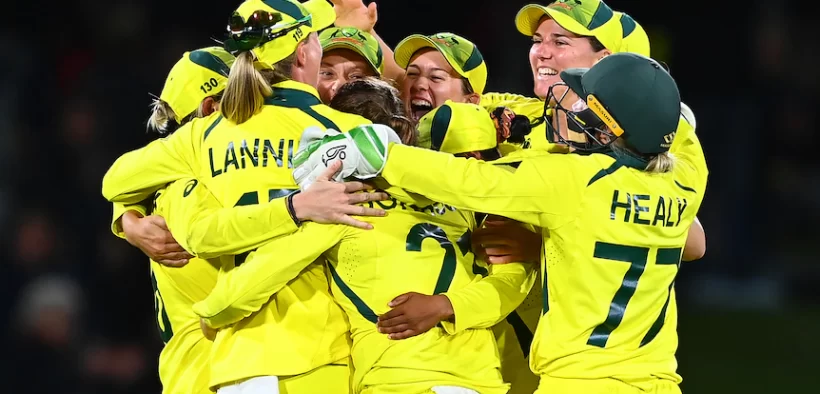Australia wins seventh women’s Cricket World Cup, as Alyssa Healy’s record-breaking 170 outdoes Nat Sciver’s century

Australia currently holds the women’s ODI and T20 titles, after winning the latter in 2020.(Getty: Hannah Peters)
Australia has won its seventh women’s ODI World Cup, beating England by 71 runs in the final on the back of a record-breaking innings by Alyssa Healy.
Healy notched the highest score in a women’s or men’s World Cup final, hammering 170 off 138 balls to help Australia reach 5-356 after being sent in to bat by England.
Backing up 129 in the semi-final against West Indies, Healy passed 500 runs for the tournament as she led Australia to the biggest total in a women’s final.
The opener’s gargantuan score eclipsed Adam Gilchrist’s 149 in the 2007 men’s World Cup final against Sri Lanka.
She was ably supported by Rachael Haynes (68) in a 160-run opening stand, and Beth Mooney (62) as they set England a seemingly impossible target of 357 runs to defend their ODI title.
Powerful England all-rounder Nat Sciver made a fist of the chase with a sensational 148 not out off 121 balls, but Australia took regular wickets to ensure she could not enjoy the sort of partnerships Healy had, with England eventually all out for 285.
It had all started so well for England, winning the toss and sending the Australia in to bat, but went downhill quickly thanks to Healy’s heroics and some poor dismissals during their brave chase.
Reigning world champions England lost openers Danni Wyatt (4) and Tammy Beaumont (27) to Megan Schutt in-swingers early on, bringing Sciver to the crease.
The 29-year-old, who clattered an unbeaten 109 off 85 in a run chase against Australia in England’s first match of the tournament, immediately boosted the run rate.
She was given out LBW while on 23, but she successfully overturned it on review, only to watch captain Heather Knight get trapped plumb by leg-spinner Alana King just two deliveries later.
Sciver and wicketkeeper Amy Jones scored 43 runs off the next 5.2 overs before Jones went for one big shot too many against Jess Jonassen, King taking a superb catch at mid-off.
King also bowled Sophia Dunkley around her legs for 23 and had Katherine Brunt stumped for 1 after bamboozling her with a ripping leggie in successive overs.
If England’s hopes were not already extinguished, Tahlia McGrath thoroughly smothered them when she had Sophie Ecclestone trapped LBW and Jonassen had Kate Cross caught and bowled one over later.
Number 10 Charlie Dean put on a vital 65 off 53 with Sciver before she chipped a reverse sweep off Ash Gardner into the hands of Jonassen at backward point, bringing to the crease Anya Shrubsole, who chipped a catch to Gardner to officially end the tournament and kick off celebrations for Australia.
Healy and Haynes lay the platform
England bowled well early, restricting Australia to just 37 runs in the opening ten overs, however, after building a solid base, Australia’s openers exploded.
The Healy-Haynes opening pair put on 216 runs in the semi-final against the West Indies, but the partnership in the final was almost over in the 21st over.
Both were dropped in the 40s, in the same Cross over — Haynes at backward point by Wyatt, and Healy at mid-wicket by Sciver.
Haynes reached 50 for the fourth time in the tournament one ball after Healy was dropped, and Healy also notched her half-century two overs later.
Having trailed Haynes in the scoring rate for most of their partnership, Healy put her foot on the accelerator and passed her batting partner as the boundaries began to flow.
Haynes was trying to slog one of her own when she eventually sliced an Ecclestone delivery to Beaumont behind point, uniting Healy with T20 opening partner Beth Mooney.
The new pair carried on in similarly dominant fashion, Healy adding the second 50 of her innings in just 38 balls to reach 100 at a run a ball.
Mooney also scored a half-century off just 38 balls, and Healy’s third 50 was her fastest — off just 29 balls.
She brought it up her 150, becoming the first player to do so in a World Cup final, with a loft over cover for four.
Four more boundaries followed from Healy’s bat before her time at the crease ended in the 46th over, when she chased a wide ball from Anya Shrubsole, and Jones completed a slick stumping.
Healy left the playing area to a standing ovation from the Christchurch crowd and congratulations from England players.
Australia elevated big-hitting Ash Gardner to number four but she could only add 1 before being run out, and Shrubsole added the wickets of Lanning (10) and Mooney in successive deliveries in her next over, as the Aussies looked for boundaries.
Ellyse Perry scored 17 off 10 in her return from injury and McGrath (8) was the other not-out batter as they helped Australia score 120 runs off the final 10 overs.
That late burst meant England was actually ahead of the game for much of their chase, but it proved to only be a mirage as they could not keep pace as the innings wore on.
ABC











